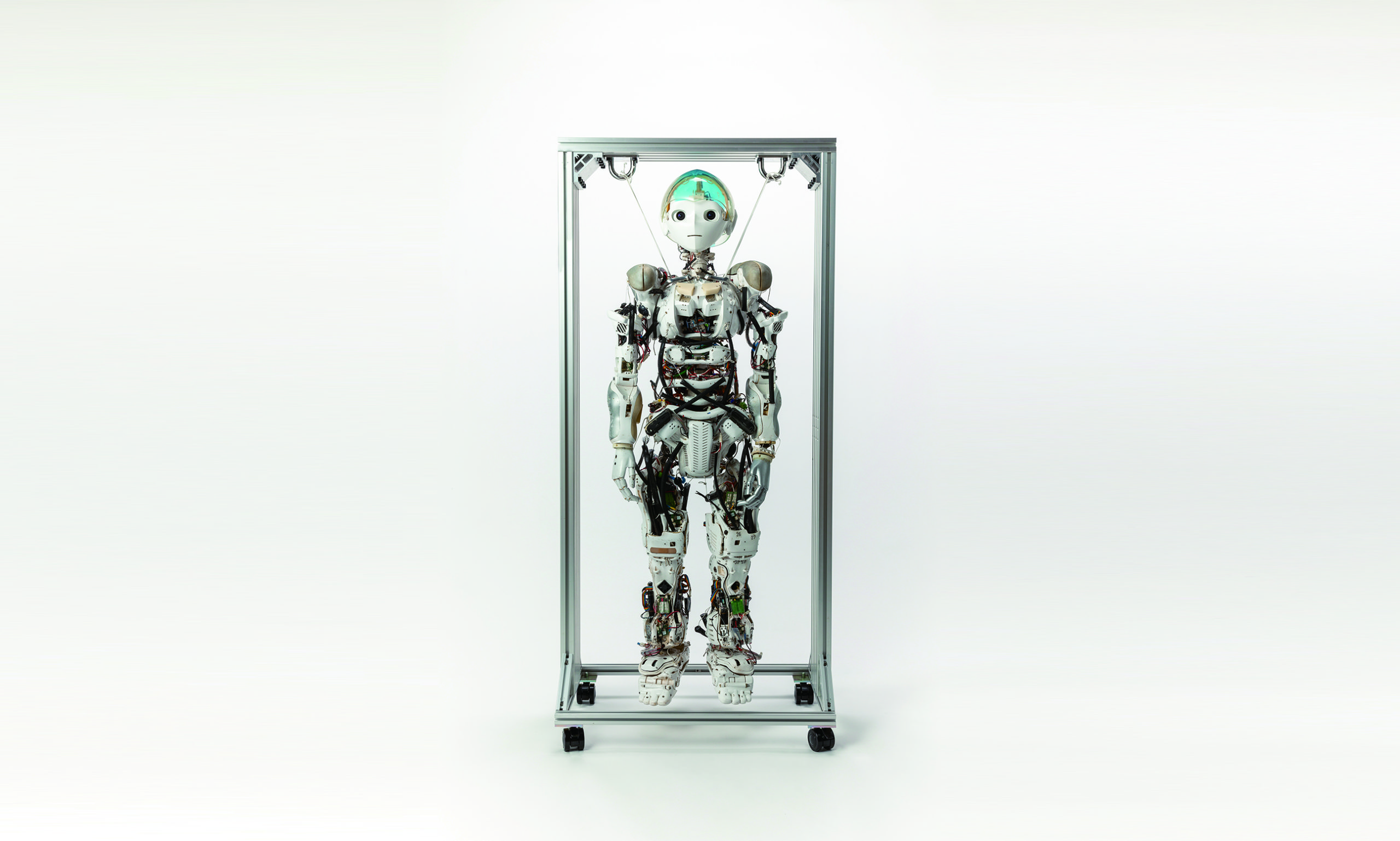筋骨格ヒューマノイド-小次郎Musculoskeletal Humanoid "Kojiro"
機械情報工学科Department of Mechano-Informatics

人は、200を超える骨とそれらを動かす多くの筋をもつ身体を乳幼児から高齢者になるまで扱います。ヒューマノイドは通常、全身で3〜40個の人より少ない関節をもつ身体で生活支援研究がなされますが、人のように筋・骨の数が多く冗長性の高い身体をどのように動かすことで自身の身体を扱えるように学習し、環境へ適応するかは明らかとなっていません。
筋骨格ヒューマノイド小次郎は、4節の脊椎構造による背骨関節や全身で109本の筋、軽量な樹脂からなる骨をもつ身体であっても、強度を保った行動を実現するために開発されました。肩構造の球体型胸郭-鎖骨-肩甲骨により上肢の広い可動域を実現し、手首は非線形特性をもつバネを拮抗させ、関節剛性を可変とし、衝突や接触時に環境になじみます。脚は、樹脂であっても高い剛性を保ち、2脚自立、センサーベースドな反射型歩行、太鼓叩き、背骨を用いた運動などのさまざまな行動実験がなされました。
小次郎の後、筋配置、骨構造も人に似せた腱志郎、腱悟郎へと進化させる礎となったものです。
筋骨格ヒューマノイド
2007
寸法:1350×700×700
重量:45kg
制作:東京大学大学院情報理工学系研究科 知能機械情報学専攻 情報システム工学研究室
所蔵:東京大学大学院情報理工学系研究科 知能機械情報学専攻
筋骨格ヒューマノイド小次郎は、4節の脊椎構造からなる背骨関節や全身で109本の筋、軽量な樹脂からなる骨をもつ身体であっても、強度を保ち行動が可能かを研究テーマとして開発されたロボット。
Human beings manage quite complex body from infant to the aged, which is composed of numerous number of muscles and more than 200 bones. On the other hand, ordinary Humanoids are composed of 3-40 number of joints in total, and it is not clear how humanoid become able to act as adaptively to the environment from learning how to move its complex body with high redundancy by numerous number of muscles and bones as humans do.
Musculoskeletal Humanoid Kojiro has been developed along with a research theme that how it becomes able to act with maintaining strength of its body, even if it is composed of skeletal structure made of resin lighter than metal and 109 number of muscle actuators. Wide joint range in upper limb is achieved by spherical thorax – collar bone – scapula connection in the shoulder. Thanks to variable stiffness in the wrist by antagonistic arrangement of non-linear springs, the wrist can adapt to the environmental contact or collision. Leg structure has high strength and stiffness even it is made of resin. Various number of experiments with Kojiro have been conducted, such as standing with two legs, sensor-based reflective walking, playing Japanese drum, or exercising using spine.
Kojiro is the fundamental base of advanced successors Kenshiro and Kengoro, which are composed of human mimetic musculoskeletal structures with high bio-fidelity to humans in terms of muscle arrangements and skeletal structures.
Musculoskeletal humanoid
2007
Size: 1350×700×700
Weight: 45kg
Production: JSK Robotics Laboratory, Department of Mechano-Informatics, Graduate School of Information Science and Technology, The University of Tokyo
Collection: Department of Mechano-Informatics, Graduate School of Information Science and Technology, The University of Tokyo
Musculoskeletal humanoid Kojiro have been developed along with research theme that how it become able to act with maintaining strength of its body even if it is composed of skeletal structure made of resin lighter than metal, 4 joints spine structure by vertebrae components, and 109 number of muscle actuators.

